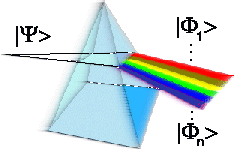Jul 28, 2003
Pair-correlation function of a metastable helium Bose-Einstein condensate
The pair-correlation function is one of the basic quantities to characterize the coherence properties of a Bose-Einstein condensate. We calculate this function in the experimentally important case of a zero temperature Bose-Einstein condensate in a metastable triplet helium state using the variational method with a pair-excitation ansatz. We compare our result with a pair-correlation function obtained for the hard-sphere potential with the same scattering length. Both functions are practically indistinguishable for distances greater than the scattering length. At smaller distances, due to interatomic interactions, the helium condensate shows strong correlations
Jul 17, 2003
Probing Anderson localization of light via decay rate statistics
We have studied the distribution of resonance widths P(Γ) in one-, two-, and three-dimensional multiple light scattering systems. P(Γ) should follow a universal power law P(Γ)∼Γ-1 in the localized regime as confirmed by extensive numerical calculations. This behavior can be interpreted as an unambiguous signature of exponential Anderson localization of light in open systems.
Jul 2, 2003
Cluster explosion in an intense laser pulse
Radiation Physics and Chemistry 68, 273 (2003)
Marian Rusek, Hervé Lagadecb and Thomas Blenskib
This manuscript addresses a hot topic in the field of cluster physics: the explosion of rare-gas atomic clusters induced by short, intense laser pulses. Within the Thomas–Fermi model we have developed an numerical approach for an explicitly time-dependent description of small to medium size clusters in 3D. Such an approach, though strongly simplified in comparison to fully quantum-mechanical schemes, is nevertheless expected to yield a qualitatively correct description of the electronic and ionic dynamics of these systems, at a much lower computational cost.
Marian Rusek, Hervé Lagadecb and Thomas Blenskib
This manuscript addresses a hot topic in the field of cluster physics: the explosion of rare-gas atomic clusters induced by short, intense laser pulses. Within the Thomas–Fermi model we have developed an numerical approach for an explicitly time-dependent description of small to medium size clusters in 3D. Such an approach, though strongly simplified in comparison to fully quantum-mechanical schemes, is nevertheless expected to yield a qualitatively correct description of the electronic and ionic dynamics of these systems, at a much lower computational cost.
Subscribe to:
Comments (Atom)
